Outage Probability Analysis and Transmit Power Optimization for Blind-Reconfigurable Intelligent Surface-Assisted Non-Orthogonal Multiple Access Uplink
Abstract
1. Introduction
2. Related Work
- The majority of the research assumes intelligent RIS, where the BS-RIS and RIS-users’ channels are known in advance at the RIS. Each RIS element in these models is supposed to pre- and post-cancel the phase distortions brought on by the related channels. The channels are rapidly varying in applications such as V2X. It is quite difficult to gather precise channel information for every user, especially when there are many users and reflecting elements;
- The majority of classic works presuppose the deployment of RIS between the transmitter and receiver. The received signal at the RIS may be quite weak when it is far from the transmitter. RIS may not therefore provide the anticipated benefits. The majority of studies examined the sum capacity and outage probability for RIS when configured as an SR. These models might not be realistic in all scenarios;
- Further, it is also noted that outage analysis and optimal power allocation for near user and far user of the uplink NOMA system with RIS have not been addressed.
- Two different system models are proposed for the blind-RIS-assisted uplink NOMA system:
- RIS is modeled as a smart reflector (SR) for the near and far users of the uplink NOMA system and it is termed as blind-RIS-SR-NOMA.
- RIS is modeled as an access point (AP) for the near and far users of the uplink NOMA system and it is termed as blind-RIS-AP-NOMA.
- The optimization problem is formulated to allocate optimal powers at both near and far users to maximize the sum rate of the proposed uplink NOMA systems. Closed-form expressions for optimal power allocation are also obtained by solving the optimization problem;
- Extensive Monte-Carlo simulations are performed to corroborate the closed-form expressions that have been derived. The analytical and simulation curves are nearly identical, indicating that the obtained expressions are accurate.
3. Outage Analysis of Blind-RIS-NOMA Uplink System
3.1. Outage Probability of the Blind-RIS-SR-NOMA System for Uplink Transmission
3.1.1. System Model
3.1.2. Outage Analysis for User 1
3.1.3. Outage Analysis for User 2
3.2. Outage Probability of Blind-RIS-AP-NOMA System for Uplink Transmission
4. Optimal Power Allocation for Uplink Sum Capacity Maximization
5. Results and Discussion
6. Conclusions
Author Contributions
Funding
Institutional Review Board Statement
Informed Consent Statement
Data Availability Statement
Acknowledgments
Conflicts of Interest
Nomenclature
| Symbol | Description |
| Unit average energy symbol corresponding to jth user | |
| Channel between ith RIS element and BS | |
| Channel between jth user and ith RIS element | |
| Power fractions allotted to jth user | |
| Number of reflecting elements | |
| Transmit power | |
| Signal from users received at the ith RIS element | |
| Superposed signal received at the BS | |
| Complex Gaussian noise added at the BS | |
| Combined channel effect of user 1 to BS | |
| Combined channel effect of user 2 to BS | |
| Instantaneous channel gain of jth user | |
| SINR of user 1 at BS | |
| Transmit SNR | |
| Desired rate of jth user | |
| Probability of outage of jth user of proposed system | |
| SNR of user 2 | |
| Optimal power allocated to jth user | |
| Sub-optimal power allocated to jth user | |
| Probability of outage of jth user of NOMA system | |
| Average channel gain of jth user of traditional NOMA |
Appendix A. Condition for an Outage at User 1
Appendix B. CDF of
Appendix C. The Outage Probability Expression of User 1
Appendix D. Condition for No Outage at User 2
Appendix E. Probability of No Outage at User 2
Appendix F. Lower Bound of Optimal μ1
Appendix G. Upper Bound of Optimal μ1
Appendix H. Identifying the Feasibility Region
References
- Liu, R.; Wu, Q.; Renzo, M.D.; Yuan, Y. A path to smart radio environments: An industrial viewpoint on reconfigurable intelligent surfaces. Wirel. Commun. 2022, 29, 202–208. [Google Scholar] [CrossRef]
- Available online: https://www.insidetelecom.com/hibernating-5g-stations-in-china-to-save-energy/ (accessed on 20 May 2022).
- Renzo, D.M.; Zappone, A.; Debbah, M.; Alouini, M.-S.; Chau, Y.; de Rosny, J.; Tretyakov, S. Smart radio environments empowered by reconfigurable intelligent surfaces: How it works, state of research, and the road ahead. IEEE J. Sel. Areas Commun. 2020, 38, 2450–2525. [Google Scholar] [CrossRef]
- Wu, Q.; Zhang, R. Intelligent reflecting surface enhanced wireless network via joint active and passive beamforming. IEEE Trans. Wirel. Commun. 2019, 18, 5394–5409. [Google Scholar] [CrossRef]
- Liu, Y.; Zhang, S.; Mu, X.; Ding, Z.; Schober, R.; Al-Dhahir, N.; Hossain, E.; Shen, X. Evolution of NOMA toward next generation multiple access (NGMA) for 6G. IEEE J. Sel. Areas Commun. 2022, 40, 1037–1071. [Google Scholar] [CrossRef]
- Yuan, Y.; Wang, S.; Wu, Y.; Poor, H.V.; Ding, Z.; You, X.; Hanzo, L. NOMA for next-generation massive IoT: Performance potential and technology directions. IEEE Commun. Mag. 2021, 59, 115–121. [Google Scholar] [CrossRef]
- Aldababsa, M.; Toka, M.; Gökçeli, S.; Kurt, G.K.; Kucur, O. A tutorial on nonorthogonal multiple access for 5G and beyond. Wirel. Commun. Mob. Comput. 2018, 2018, 9713450. [Google Scholar] [CrossRef]
- Li, S.; Duo, B.; Yuan, X.; Liang, Y.C.; Renzo, D.M. Reconfigurable intelligent surface assisted UAV communication: Joint trajectory design and passive beamforming. IEEE Wirel. Commun. Lett. 2020, 9, 716–720. [Google Scholar] [CrossRef]
- Tan, X.; Zhi, S.; Jornet, J.M.; Pados, D. Increasing indoor spectrum sharing capacity using smart reflect-array. In Proceedings of the 2016 IEEE International Conference on Communications (ICC), Kuala Lumpur, Malaysia, 22–27 May 2016; pp. 1–6. [Google Scholar]
- Liu, Y.; Qin, Z.; Elkashlan, M.; Gao, Y.; Hanzo, L. Enhancing the physical layer security of non-orthogonal multiple access in large-scale networks. IEEE Trans. Wirel. Commun. 2017, 16, 1656–1672. [Google Scholar] [CrossRef]
- Xiu, Y.; Zhao, J.; Basar, E.; Renzo, M.D.; Sun, W.; Gui, G.; Wei, N. Uplink achievable rate maximization for reconfigurable intelligent surface aided millimeter wave systems with resolution-adaptive ADCs. IEEE Wirel. Commun. Lett. 2021, 10, 1608–1612. [Google Scholar] [CrossRef]
- Yang, L.; Meng, F.; Hasna, M.O.; Basar, E. A novel RIS-assisted modulation scheme. IEEE Wirel. Commun. Lett. 2021, 10, 1359–1363. [Google Scholar] [CrossRef]
- Yildirim, I.; Kilinc, F.; Basar, E.; Alexandropoulos, G.C. Hybrid RIS-empowered reflection and decode-and-forward relaying for coverage extension. IEEE Commun. Lett. 2021, 25, 1692–1696. [Google Scholar]
- Jalaja, R.R.U.; Thirumavalavan, V.C.; Velmurugan, P.G.S.; Thiruvengadam, S.J.; Thiruvengadam, S.J. Spatially correlated dual hop ris aided next generation wireless systems: An outage perspective. IEEE Access 2021, 9, 56127–56139. [Google Scholar] [CrossRef]
- Yildirim, I.; Uyrus, A.; Basar, E. Modeling and analysis of reconfigurable intelligent surfaces for indoor and outdoor applications in future wireless networks. IEEE Trans. Commun. 2020, 69, 1290–1301. [Google Scholar] [CrossRef]
- Nain, G.; Das, S.S.; Chatterjee, A. Low complexity user selection with optimal power allocation in downlink NOMA. IEEE Wirel. Commun. Lett. 2017, 7, 158–161. [Google Scholar] [CrossRef]
- Zhang, H.; Zhang, H.; Long, K.; Karagiannidis, G.K. Deep learning based radio resource management in NOMA networks: User association, subchannel and power allocation. IEEE Trans. Netw. Sci. Eng. 2020, 7, 2406–2415. [Google Scholar] [CrossRef]
- Agarwal, A.; Chaurasiya, R.; Rai, S.; Jagannatham, A.K. Outage probability analysis for NOMA downlink and uplink communication systems with generalized fading channels. IEEE Access 2020, 8, 220461–220481. [Google Scholar] [CrossRef]
- Tegos, S.A.; Diamantoulakis, P.D.; Xia, J.; Fan, L.; Karagiannidis, G.K. Outage performance of uplink NOMA in land mobile satellite communications. IEEE Wirel. Commun. Lett. 2020, 9, 1710–1714. [Google Scholar] [CrossRef]
- Muhammed, A.J.; Ma, M.; Li, L.; Panagiotis, D.D.; Karagiannidis, G.K. Energy Efficient Power and Subcarrier Allocation for Downlink Non-Orthogonal Multiple Access Systems. In Proceedings of the 2019 IEEE 90th Vehicular Technology Conference (VTC2019-Fall), Honolulu, HI, USA, 22–25 September 2019; pp. 1–5. [Google Scholar]
- Nguyen, H.-N.; Le, C.-B.; Nguyen, T.N.; Do, D.-T. Study on outage performance gap of two destinations on CR-NOMA network. Telkomnika 2020, 18, 191–198. [Google Scholar] [CrossRef]
- Yang, G.; Xu, X.; Liang, Y.-C.; Renzo, M.D. Reconfigurable intelligent surface-assisted non-orthogonal multiple access. IEEE Trans. Wirel. Commun. 2021, 20, 3137–3151. [Google Scholar] [CrossRef]
- Ding, Z.; Schober, R.; Poor, H.V. On the impact of phase shifting designs on IRS-NOMA. IEEE Wirel. Commun. Lett. 2020, 9, 1596–1600. [Google Scholar] [CrossRef]
- Cheng, Y.; Li, K.H.; Liu, Y.; Teh, K.C.; Karagiannidis, G.K. Non-orthogonal multiple access (NOMA) with multiple intelligent reflecting surfaces. IEEE Trans. Wirel. Commun. 2021, 20, 7184–7195. [Google Scholar] [CrossRef]
- Do, D.-T.; Le, C.-B. Exploiting performance gap among two users in reconfigurable intelligent surfaces-aided wireless systems. Telkomnika 2022, 20, 1–8. [Google Scholar] [CrossRef]
- Cheng, Y.; Li, K.H.; Liu, Y.; The, K.C.; Poor, H.V. Downlink and uplink intelligent reflecting surface aided networks: NOMA and OMA. IEEE Trans. Wirel. Commun. 2021, 20, 3988–4000. [Google Scholar] [CrossRef]
- Xiu, Y.; Zhao, J.; Sun, W.; Renzo, M.D.; Gui, G.; Zhang, Z.; Wei, N. Reconfigurable intelligent surfaces aided mmWave NOMA: Joint power allocation, phase shifts, and hybrid beamforming optimization. IEEE Trans. Wirel. Commun. 2021, 20, 8393–8409. [Google Scholar] [CrossRef]
- Guo, Y.; Qin, Z.; Liu, Y.; Al-Dhahir, N. Intelligent reflecting surface aided multiple access over fading channels. IEEE Trans. Commun. 2020, 69, 2015–2027. [Google Scholar] [CrossRef]
- Chen, Y.; Wang, Y.; Zhang, J.; Renzo, M.D. QoS-driven spectrum sharing for reconfigurable intelligent surfaces (RISs) aided vehicular networks. IEEE Trans. Wirel. Commun. 2021, 20, 5969–5985. [Google Scholar] [CrossRef]
- Basar, E. Transmission through large intelligent surfaces: A new frontier in wireless communications. In Proceedings of the 2019 European Conference on Networks and Communications (EuCNC), Valencia, Spain, 18–21 June 2019; pp. 112–117. [Google Scholar]
- Basar, E.; Renzo, M.D.; de Rosny, J.; Debbah, M.; Alouini, M.-S.; Zhang, R. Wireless communications through reconfigurable intelligent surfaces. IEEE Access 2019, 7, 116753–116773. [Google Scholar] [CrossRef]
- Thirumavalavan, V.C.; Thiruvengadam, S.J. BER analysis of reconfigurable intelligent surface assisted downlink power domain NOMA system. In Proceedings of the 2020 International Conference on COMmunication Systems & NETworkS (COMSNETS), Bengaluru, India, 7–11 January 2020; pp. 519–522. [Google Scholar]
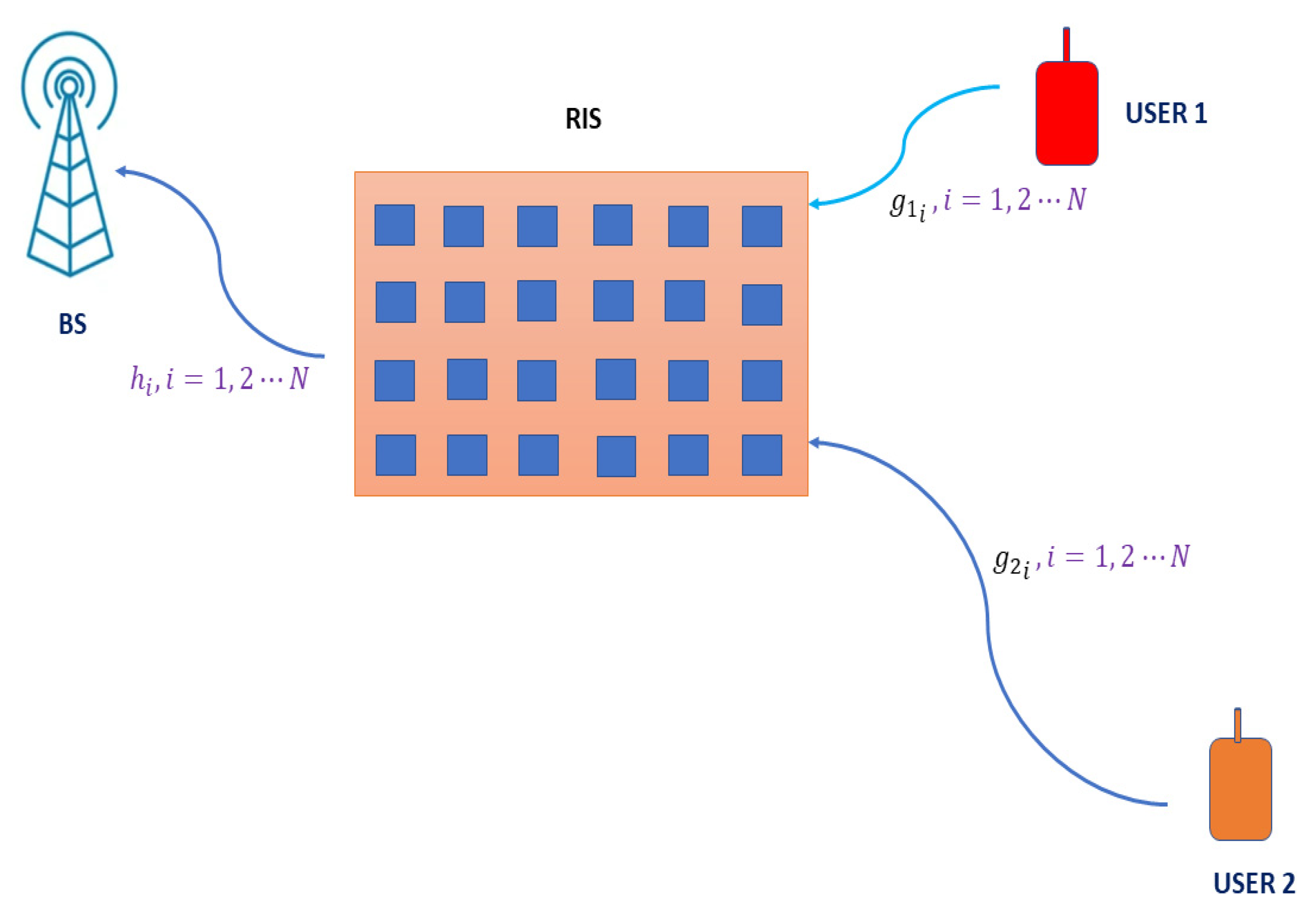


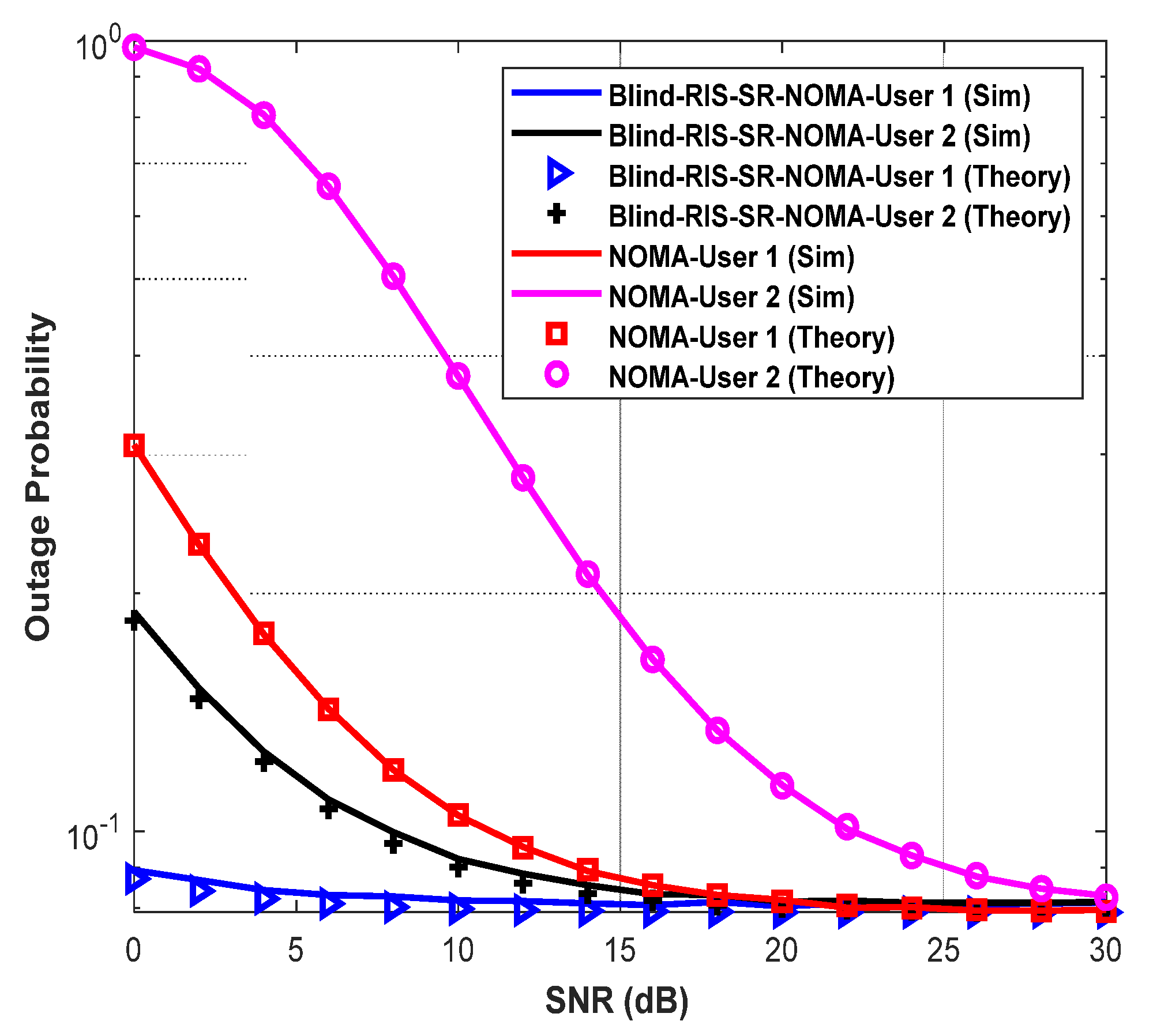
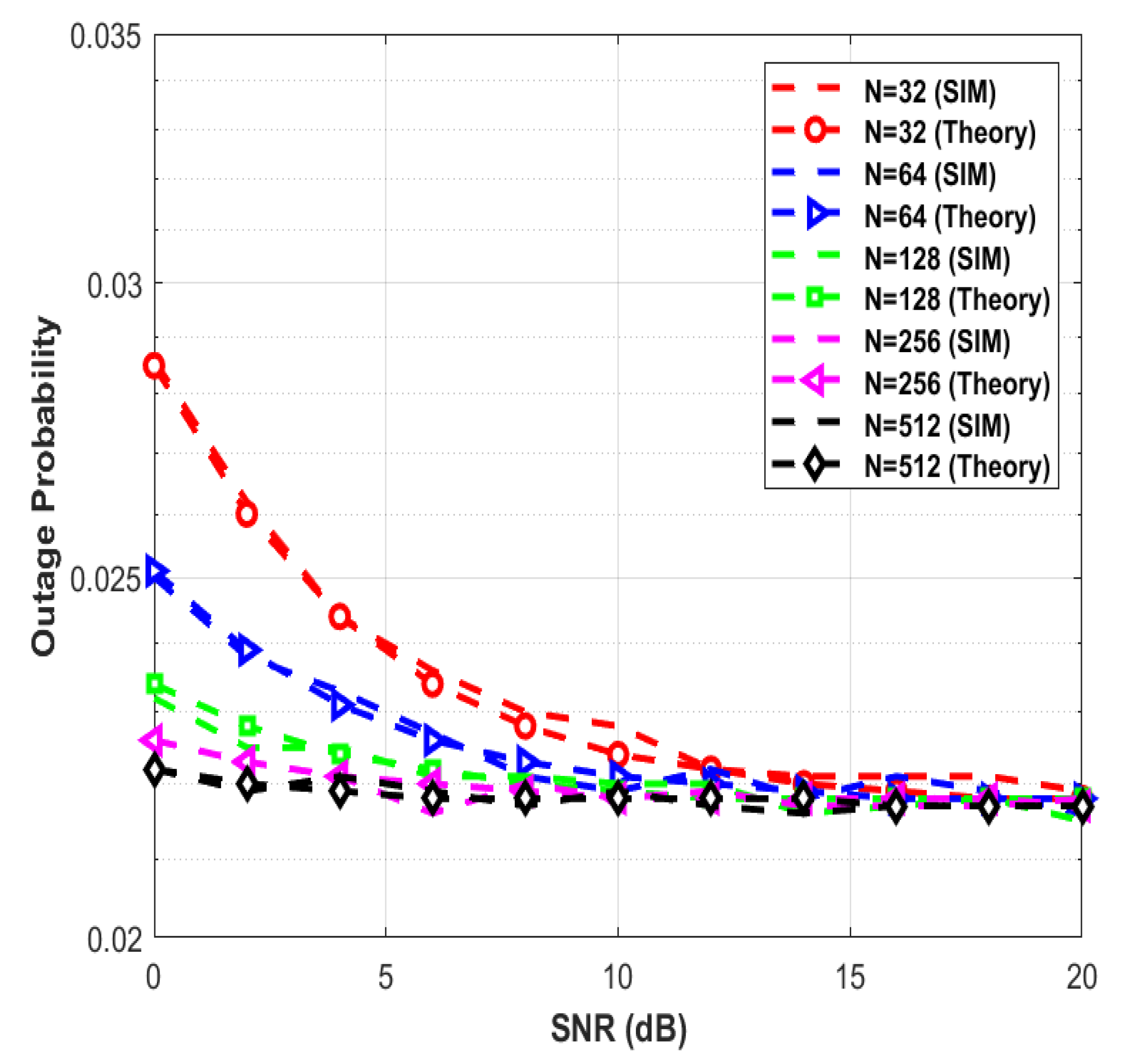

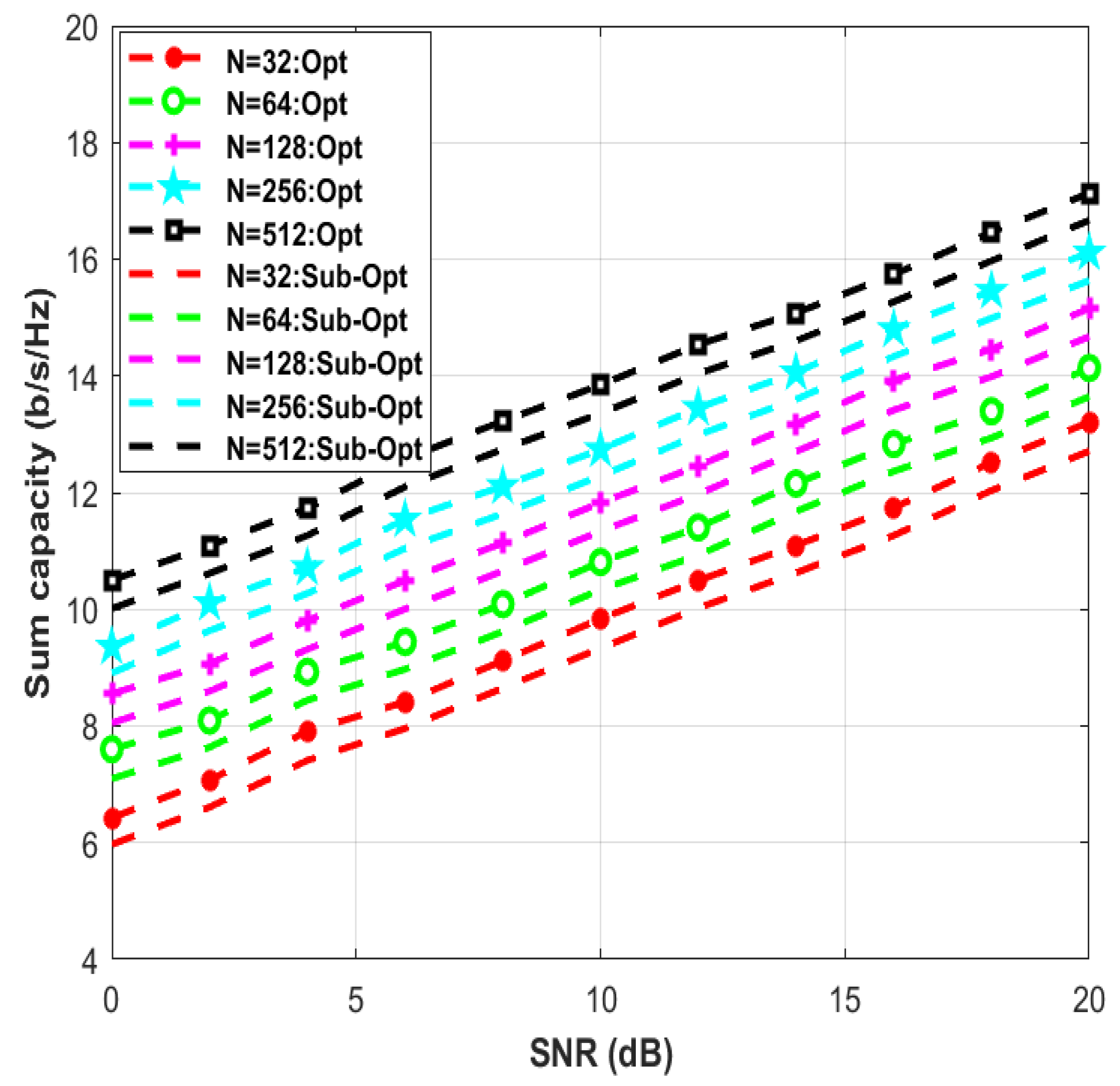

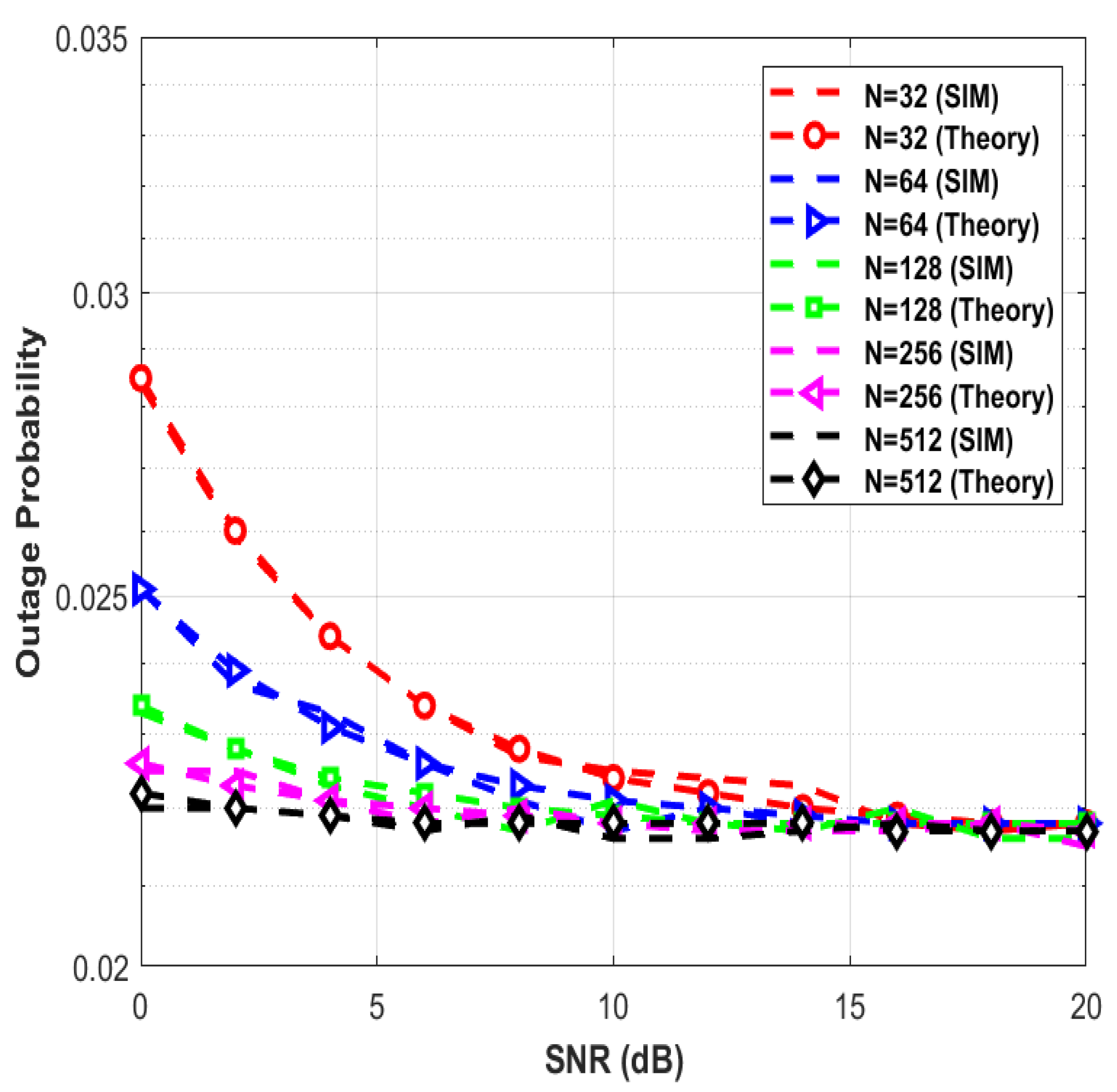
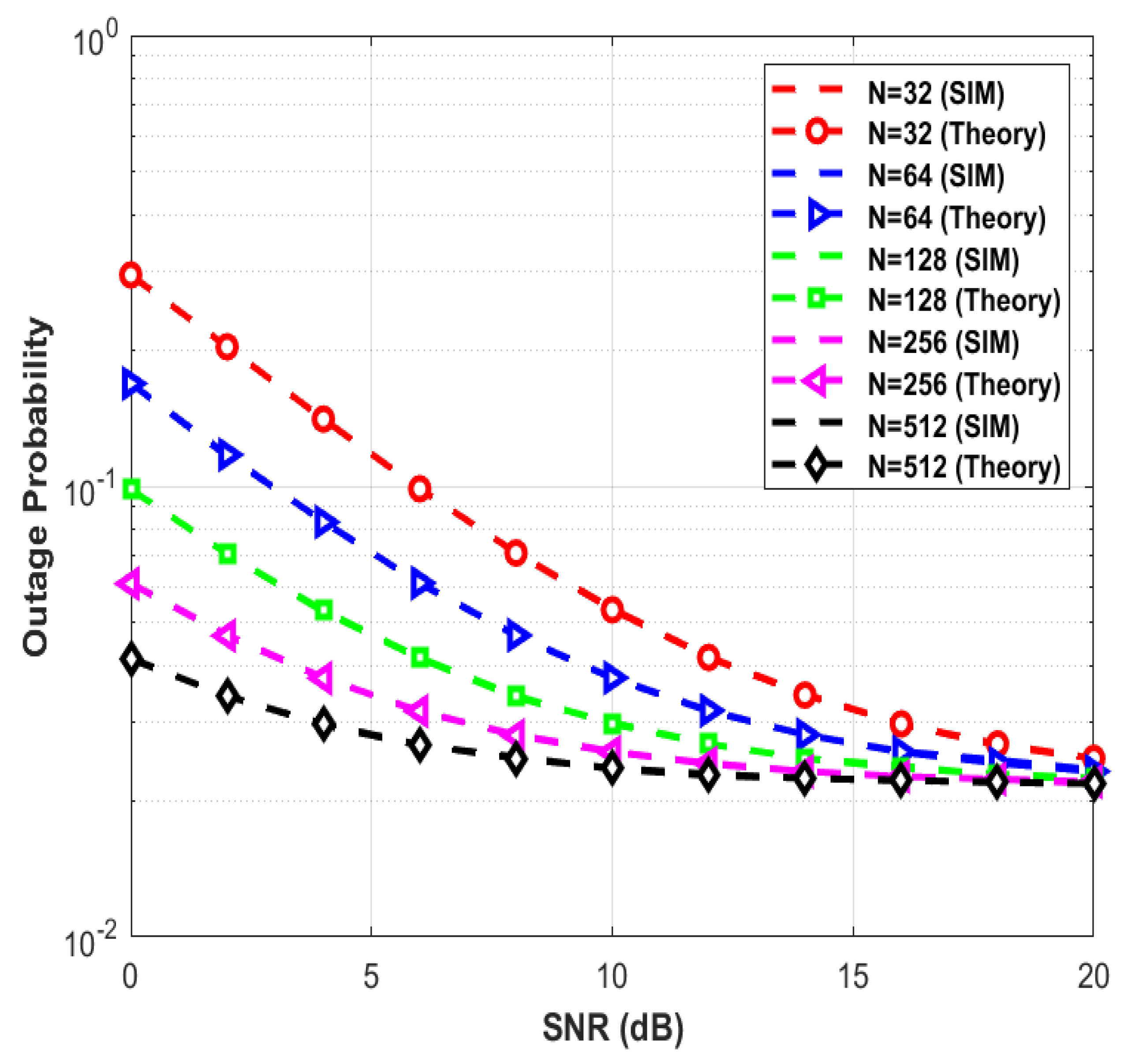


| Parameters | Value |
|---|---|
| Number of reflecting elements | 32, 64, 128, 256, 512 |
| Number of users | 2 |
| Average channel gain of user 1 | 5 |
| Average channel gain of user 2 | 1 |
| The desired rate of users (b/s/Hz) | 1 |
| Power allocated to user 1 | 0.9, 0.7 |
| Power allocated to user 2 | 0.1, 0.3 |
| Block size | 106 |
Publisher’s Note: MDPI stays neutral with regard to jurisdictional claims in published maps and institutional affiliations. |
© 2022 by the authors. Licensee MDPI, Basel, Switzerland. This article is an open access article distributed under the terms and conditions of the Creative Commons Attribution (CC BY) license (https://creativecommons.org/licenses/by/4.0/).
Share and Cite
Kumaravelu, V.B.; Imoize, A.L.; Soria, F.R.C.; Velmurugan, P.G.S.; Thiruvengadam, S.J.; Murugadass, A.; Gudla, V.V. Outage Probability Analysis and Transmit Power Optimization for Blind-Reconfigurable Intelligent Surface-Assisted Non-Orthogonal Multiple Access Uplink. Sustainability 2022, 14, 13188. https://doi.org/10.3390/su142013188
Kumaravelu VB, Imoize AL, Soria FRC, Velmurugan PGS, Thiruvengadam SJ, Murugadass A, Gudla VV. Outage Probability Analysis and Transmit Power Optimization for Blind-Reconfigurable Intelligent Surface-Assisted Non-Orthogonal Multiple Access Uplink. Sustainability. 2022; 14(20):13188. https://doi.org/10.3390/su142013188
Chicago/Turabian StyleKumaravelu, Vinoth Babu, Agbotiname Lucky Imoize, Francisco R. Castillo Soria, Periyakarupan Gurusamy Sivabalan Velmurugan, Sundarrajan Jayaraman Thiruvengadam, Arthi Murugadass, and Vishnu Vardhan Gudla. 2022. "Outage Probability Analysis and Transmit Power Optimization for Blind-Reconfigurable Intelligent Surface-Assisted Non-Orthogonal Multiple Access Uplink" Sustainability 14, no. 20: 13188. https://doi.org/10.3390/su142013188
APA StyleKumaravelu, V. B., Imoize, A. L., Soria, F. R. C., Velmurugan, P. G. S., Thiruvengadam, S. J., Murugadass, A., & Gudla, V. V. (2022). Outage Probability Analysis and Transmit Power Optimization for Blind-Reconfigurable Intelligent Surface-Assisted Non-Orthogonal Multiple Access Uplink. Sustainability, 14(20), 13188. https://doi.org/10.3390/su142013188








